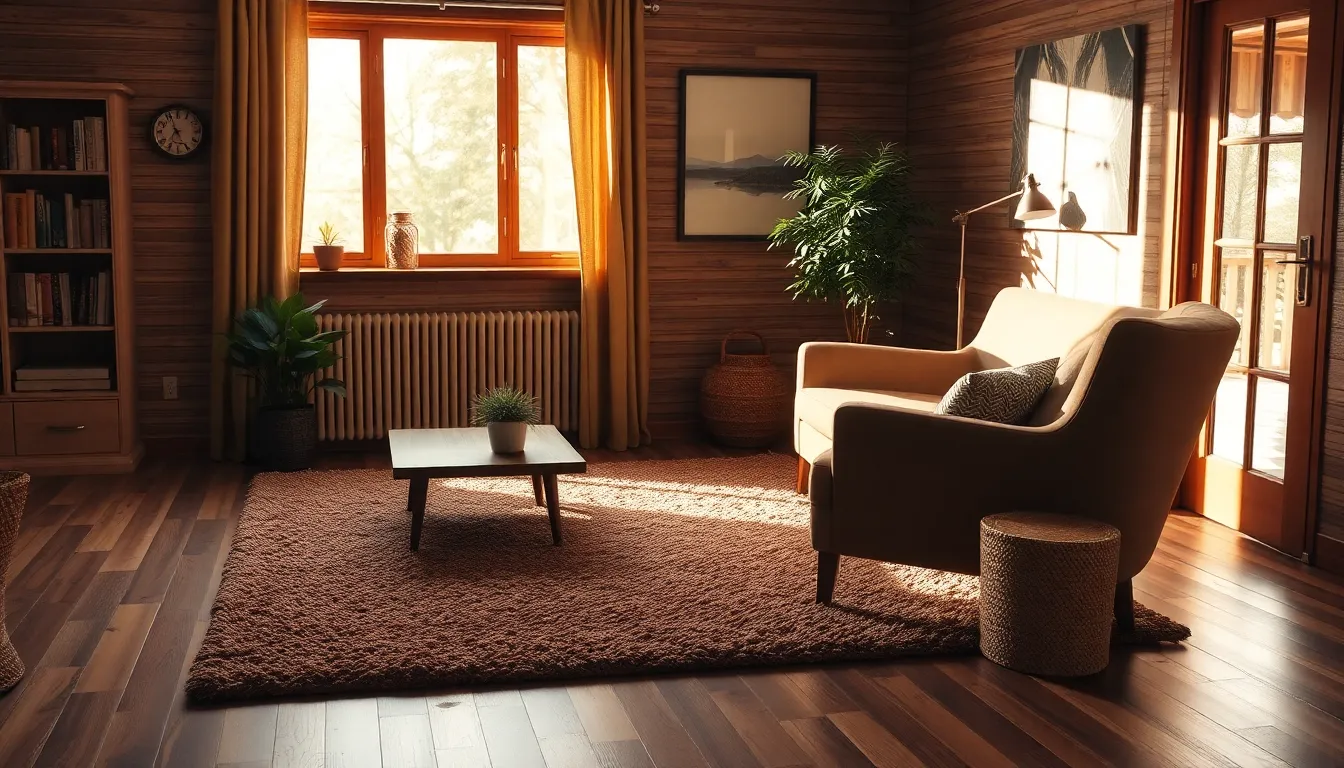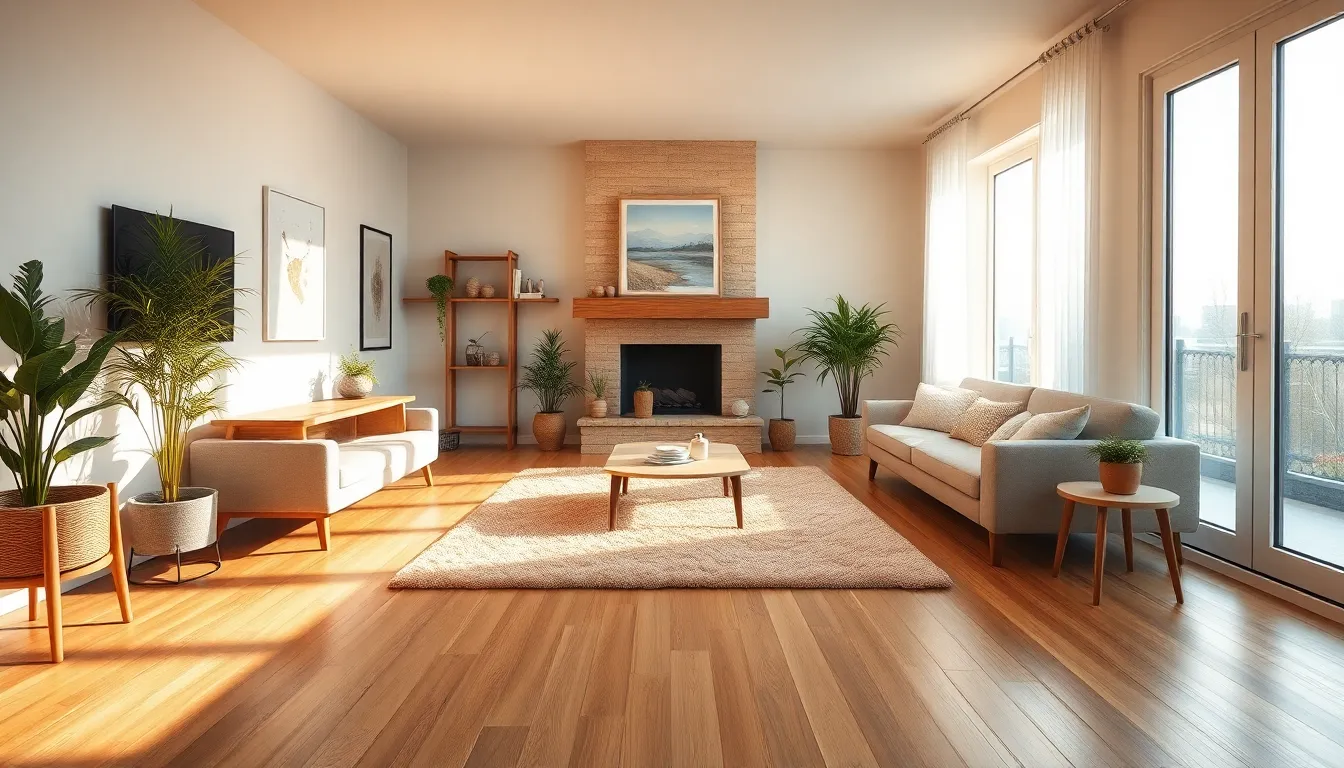Imagine stepping out of bed on a chilly morning only to be greeted by a floor that feels like a warm hug for your feet. That’s the magic of warm floor textures. They not only elevate the comfort of your home but also transform the entire vibe of a room. Who knew a floor could be so inviting?
Table of Contents
ToggleOverview of Warm Floor Textures
Warm floor textures significantly contribute to comfort in home environments. They provide a cozy feel underfoot, especially during colder months. Various materials offer distinct sensations, with some designed specifically for heat retention.
Ceramic and porcelain tiles are popular choices due to their durability and ability to retain warmth when heated. These tiles often feature textured surfaces, enhancing grip while remaining sleek. Warm wood floors add a touch of elegance and create an inviting atmosphere. Softness in wood provides a natural warmth that contrasts with the cold of winter.
Radiant heating systems can be integrated with multiple flooring options, maximizing warmth and energy efficiency. Carpeted floors offer a plush feel, trapping heat and providing insulation. These soft textures make walking barefoot a pleasurable experience.
Concrete floors also gain a place in discussions about warm textures. While typically hard, they can be designed with warming systems, allowing for efficient heating and stylish finishes. Area rugs can further enhance comfort by adding warmth and style to any space.
When choosing warm floor textures, consider the balance between aesthetic appeal and functional quality. Each material varies in maintenance and cost, impacting overall comfort and warmth. Selecting the right texture transforms a cold, uninviting floor into a warm and welcoming surface ideal for relaxation.
Benefits of Warm Floor Textures

Warm floor textures provide significant advantages, enhancing the overall comfort and aesthetic appeal of living spaces. These textures create inviting environments, particularly beneficial during colder months.
Comfort and Coziness
Warm flooring materials significantly enhance comfort levels in homes. The softness of carpeted floors provides a comforting surface underfoot, while wood and cork options offer natural warmth. Radiant heating systems installed beneath tiles or concrete create a toasty environment ideal for relaxation. Cozy living spaces become evident with these flooring types, transforming cold areas into welcoming havens. Guests appreciate the inviting nature of homes featuring warm floors, making spaces feel more liveable and enjoyable.
Energy Efficiency
Energy-efficient properties become more prominent with the installation of warm flooring. Radiant heating systems ensure even heat distribution, minimizing energy loss associated with traditional heating methods. Well-insulated floors retain warmth during winter months, reducing heating costs by up to 30%. Using materials such as cork or carpet enhances insulation, contributing to lower energy consumption. Selecting energy-efficient floor textures promotes sustainability, ensuring comfortable living environments while minimizing environmental impact.
Types of Warm Floor Textures
Warm floor textures come in various materials, each offering unique benefits and an inviting feel. Understanding the different types helps in making an informed decision that enhances comfort and style.
Carpet
Carpet provides excellent insulation against cold floors, making spaces feel cozy. Soft textures underfoot ensure comfort during chilly mornings and evenings. Numerous colors and patterns allow for personalization, transforming any room’s aesthetic. Maintenance typically involves regular vacuuming and occasional deep cleaning to keep it looking fresh. Carpets also help with sound absorption, creating a quieter, more serene environment. Overall, they serve as both a practical and beautiful warm flooring option.
Cork
Cork flooring is renowned for its natural warmth and resilience. The unique cellular structure of cork provides cushioning and insulation, perfect for cold climates. Sustainable and eco-friendly, cork is harvested without harming trees, making it an environmentally conscious choice. Installation is often straightforward, and it can be refinished to extend its life. Additionally, cork has natural antimicrobial properties, promoting hygiene in living spaces. It strikes an excellent balance between comfort, functionality, and sustainability.
Wood
Wood floors exude warmth and elegance, enhancing any room’s ambiance. Each plank showcases unique grains and colors, contributing to a timeless design. Natural wood retains heat well, providing comfort during colder months. Installation can involve various methods, such as nail-down or floating, adapting to different preferences. Regular maintenance, including refinishing, can keep wood floors looking stunning for years. Ultimately, wood offers a sophisticated, warm flooring option that appeals to many homeowners.
Maintenance of Warm Floor Textures
Maintaining warm floor textures requires specific care tailored to each type of material. Carpet benefits from regular vacuuming to remove dirt and allergens. Scheduled deep cleaning every 6 to 12 months helps preserve its appearance and texture.
Wood floors need periodic dusting to avoid scratches. For deeper cleaning, use a damp mop with a wood floor cleaner every few weeks. It’s crucial to avoid excess moisture, as water can damage the wood’s integrity.
Cork flooring necessitates minimal maintenance. Regular sweeping keeps dirt at bay, while occasional mopping with a damp cloth is sufficient. To maintain its finish, applying a sealant every few years helps protect against wear and stains.
Ceramic and porcelain tiles require straightforward care. Sweeping or vacuuming regularly prevents dirt buildup, and mopping with a mild detergent ensures cleanliness. Grout lines may need special attention; using a grout cleaner keeps them looking fresh and bright.
Concrete floors also need unique consideration when heated. They should be swept or vacuumed often, and a damp mop with a mild cleaner can maintain shine and cleanliness. Utilizing a sealer every few years protects against stains and enhances durability.
Each flooring type presents its own specific requirements for maintenance. Adhering to these practices extends the lifespan and beauty of warm floor textures. Prioritizing proper care leads to a long-lasting, inviting atmosphere in any home.
Installation Considerations
Selecting warm floor textures involves specific installation considerations that ensure optimal performance and comfort. First, a professional assessment of the subfloor is necessary. The condition of the subfloor determines the appropriateness of various materials, including ceramic and wood.
Radiant heating systems require careful planning. It’s essential to install the heating element before laying the flooring material. Proper insulation beneath the system enhances efficiency and reduces energy costs significantly.
Next, flooring material choice impacts installation. Hardwood floors demand a suitable underlayment for moisture control and thermal insulation. In contrast, carpet can often be installed directly onto the subfloor with minimal prep work.
Preparation takes precedence during installation. Clean and dry surfaces are crucial for optimal adhesion. Following manufacturer’s guidelines helps maintain warranty validity and performance standards.
Acclimating materials before installation is also vital. Allowing wood or cork to adjust to room temperature eliminates expansion or contraction issues. Each material typically needs different acclimation times, often ranging from 24 to 72 hours.
Consideration of layout enhances aesthetic appeal. Planning the direction of planks or tiles contributes to a visually pleasing outcome. It’s wise to align patterns with natural light and focal points within the room.
Finally, ongoing upkeep should be part of the installation plan. Anticipating maintenance needs ensures sustained beauty and longevity. Familiarity with care requirements for each material type greatly aids in preserving warm floor textures.
Warm floor textures undeniably elevate the comfort and aesthetic appeal of any living space. They create inviting environments perfect for relaxation and enjoyment, especially during colder months. Homeowners can choose from a variety of materials like carpet, wood, and cork to suit their style and functional needs.
Investing in radiant heating systems can enhance energy efficiency while ensuring even heat distribution. With proper maintenance and installation practices, these warm floor textures can provide lasting beauty and comfort. Ultimately, the right choice in flooring transforms a house into a cozy home, making it a welcoming retreat for family and guests alike.








